- Unit25 Jul 2012
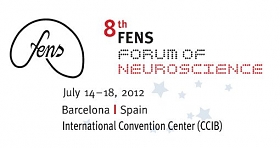
At the 8th FENS forum of neuroscience held in Barcelona, aside from The Brain Prize 2011 lecture given by Peter Somogyi, the laboratory presented three posters which were all well attended.
Linda Katona, a DPhil student, and Dr. Damien Lapray, presented their work on the activity of different identified interneuron types in the hippocampal CA1 area of freely behaving rats. Their respective posters were entitled “Behaviourally-defined activity dynamics of GABAergic O-LM interneurons in the rat hippocampus” and “Behavioural state-dependent contribution of identified CA1 stratum pyramidale GABAergic interneurons and pyramidal cells to network activity”.
The third poster, by Dr. Tim Viney, presented data on the “Inhibition of identified hippocampal CA3 axo-axonic interneurons during network oscillations in vivo” using an anaesthetised preparation.
- Unit24 Jul 2012
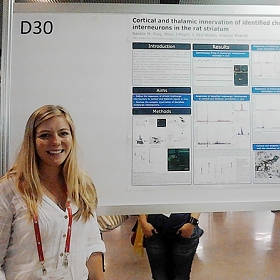
At the 8th FENS forum of neuroscience Natalie Doig presented a poster entitled “Cortical and thalamic innervation of identified cholinergic interneurons in the rat striatum”. Cholinergic interneurons are known to have an important role in reward related behaviour. Natalie has been investigating the excitatory, glutamatergic innervation to these specialised interneurons using a combination of electrophysiological and anatomical techniques (see attached poster).
The FENS forum of neuroscience is held every two years, and this year it was held in Barcelona, a city famous for its rich cultural heritage and the architectural works of Gaudi. The next FENS forum will be held in Milan, July 5 – 9, 2014.
- Unit11 Jul 2012
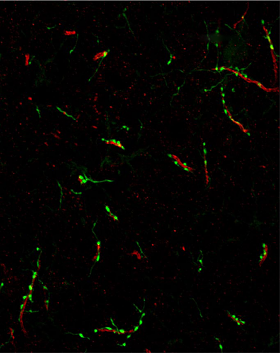 Functions of axo-axonic interneurons in the amygdala
Functions of axo-axonic interneurons in the amygdalaCoordination of neuronal activity between two brain areas, the amygdala and the hippocampus, as well as precisely-timed integration of sensory inputs in the amygdala, are critical for emotional memories. Amygdala neurons that release the inhibitory neurotransmitter GABA (GABAergic cells) are expected to play key roles in these events, but their precise identity and function are not known.
New research by the Capogna and Magill groups in the Unit sheds new light on the functional roles of various GABAergic cell types of amygdala in orchestrating network oscillations and responses to intense sensory stimulation. Bienvenu et al. discovered that distinct types of GABAergic cell fulfil specialised and complementary roles in regulating network activities of amygdala. They identified and fully characterized for the first time the activity of four types of GABAergic cells in the rat amygdala: axo-axonic cells, parvalbumin-expressing basket cells, calbindin-expressing dendrite targeting cells, and “AStria (amygdala-striatum transitional area)-projecting” cells.
- First comprehensive definition of GABAergic cell types in the amygdala
- Identification of the neuronal connectivity of each cell type
- GABAergic cell-type-specific coding of hippocampal rhythmic activity and sensory stimuli
- Unit9 Jul 2012
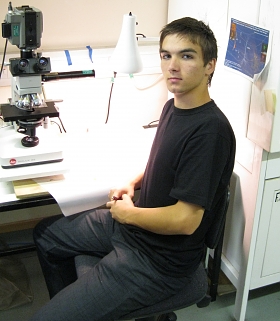
We are delighted to welcome back István Lukács, a visiting 2nd year medical student from the Medical University of Targu Mures, Romania to Peter Somogyi's lab for a month long visit. Istvan was a previous winner of Oxford Cajal Scholarship scheme. He joins a project on mouse models of neurodegenerative human brain disorders and carries out molecular and microscopic analyses on mouse brains.
- Unit5 Jul 2012
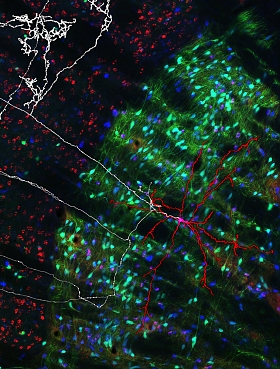 Parasagittal section of the striatum and external globus pallidus (to the left and right, respectively), showing immunofluorescence for parvalbumin (green), preproenkephalin (red), and the pan-neuronal marker HuCD (blue). Prototypic neurons of the globus pallidus express parvalbumin (green/turquoise), whereas arkypallidal neurons instead express preproenkephalin (evident as pink signal). The single arkypallidal neuron in the foreground (soma/dendrites in red, axon in white) exclusively innervates striatum, another hallmark of this novel cell type.
Parasagittal section of the striatum and external globus pallidus (to the left and right, respectively), showing immunofluorescence for parvalbumin (green), preproenkephalin (red), and the pan-neuronal marker HuCD (blue). Prototypic neurons of the globus pallidus express parvalbumin (green/turquoise), whereas arkypallidal neurons instead express preproenkephalin (evident as pink signal). The single arkypallidal neuron in the foreground (soma/dendrites in red, axon in white) exclusively innervates striatum, another hallmark of this novel cell type.Movement difficulties in people with Parkinson’s disease arise because of the disturbed electrical activity of nerve cells in the brain. Excessive rhythmic activities called ‘beta oscillations’ are one key disturbance. Research carried out at the Unit has given new insights into why and how these beta oscillations might emerge throughout the Parkinsonian brain. By matching the electrical activity of individual nerve cells to their connections, members of the Magill group have discovered that two different types of cell in a brain area called the external globus pallidus (GPe) could perform a division of labour to control many other areas important for movement. In their recently published paper, the team also reveal a novel type of GPe cell that provides massive and specific connections to the striatum, a brain area that is of central importance in Parkinson’s. Because these remarkable GPe cells are positioned to cast wide nets of influence over their targets, they were termed “arkypallidal neurons” (from ancient Greek αρκυς [arkys] for ‘hunter’s net’). Dr. Magill commented, “Exposing the striking diversity of GPe cells is a game changer for the field. The challenge ahead now is to explain the building blocks and necessity of this diversity”.
This research was highlighted in 'Neuroanatomy: Out with the old (model)' by Leonie Welberg, Nature Reviews Neuroscience 13, 518-519 (August 2012).
- Unit3 Jul 2012
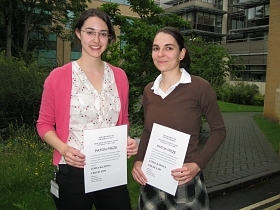 Chloe Lim (left) and Linda Katona
Chloe Lim (left) and Linda KatonaThe Paton Prize is awarded each year to the student who gives the best transfer talk in the Department of Pharmacology at the end of their second year of doctoral studies, and is in memory of Professor Sir William Paton previous head of the Department.
In recognition of their excellent standard of presentation Linda Katona and Chloe Lim were awarded jointly the 2012 Paton Prize.
Linda Katona, of Peter Somogyi’s group, delivered a short presentation of her results entitled “GABAergic neurons in hippocampal network activity of freely moving rats”. She shares the prize with Chloe Lim, of Professor Chris Garland’s group, Department of Pharmacology. Chloe’s presentation was entitled “A novel signaling role for NAADP in vascular smooth muscle cells”.
Adjudicators were Dr Sarah Newey, Professor Helga Refsum and Professor Arthur Weston.
Gengyu Li “Nitric oxide modulates synaptic inhibition in the stratum lacunosum moleculare of the hippocampus“ and Michael Crump “Diverse firing of medial septal neurons and their hippocampal targets”, second year post-graduate students at the Unit also presented their results.
- Unit3 Jul 2012

In a recent publication an interesting art-science collaboration is described. Do You Mind? paired early career neuroscientists with artists to develop cross-disciplinary dialogue, and innovative artworks. The project was initiated and co-curated by Bolam Group member Dr Megan Dowie before she joined the ANU.
This photo is the feature image for the PLoS Biology June 2012 issue. When artist Tom Henry visited Renee Gordon in her neurodegeneration research lab she showed him cultured astrocytes using a fluorescent microscope (shown in green, nuclei in blue). Tom commented that her images "evoked everything from star-like galaxies to seaweed forests," and in response produced prints by pressing paint between surfaces to create semi-symmetric shapes, referencing brain hemispheres and regeneration of cells (image credit: Renee Gordon).
Megan has recently set up another art-science collaboration, between the Basal Ganglia researchers at the ANU and artists from Central Saint Martins in London. What began as a lab visit will culminate in an exhibition in October. Details about A Nervous Encounter will follow.
- Unit3 Jul 2012
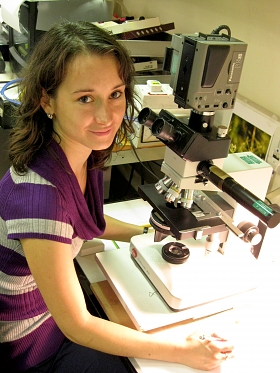
We are pleased to welcome Timea Szabadi to the Unit. She has joined Professor Peter Somogyi’s group on a 3 month Erasmus student exchange scholarship and during her time in the Unit she will explore signalling mechanisms in the brain in relation to rhythmic networks activity in the hippocampus. She will carry out immunohistochemistry for the characterization of neurons recorded in vivo. Timea is currently a 5th year medical student at the University of Medicine & Pharmacy, Targu Mure, Romania.
- Unit29 Jun 2012
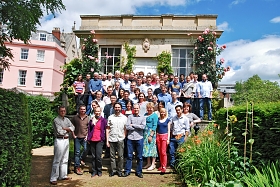
The Unit held its Summer Science Day on Friday 29 June 2012. The event this year was held at the TS Eliot Theatre, Merton College, founded in 1264, is one of the oldest colleges in Oxford and, with its medieval buildings, one of the most beautiful.
Presentations featured ongoing projects and future proposals.
- Unit25 Jun 2012
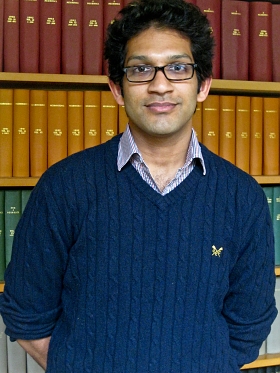
Dr Rahul Shah graduated with honours from Leicester Medical School in 2010 and joins the unit from Southampton General Hospital where he is an Academic Foundation Doctor in Neurosurgery. During his medical degree he intercalated a BSc in the Neural Plasticity Lab under Robert Pawlak, and undertook electives at the University of Cape Town and Mayo Clinic Rochester.
Rahul is undertaking a 4-month research rotation in the Magill group supervised by Dr Andrew Sharott, utilising in vivo electrophysiology to investigate properties of novel fast-spiking interneurons in the dorsolateral striatum.